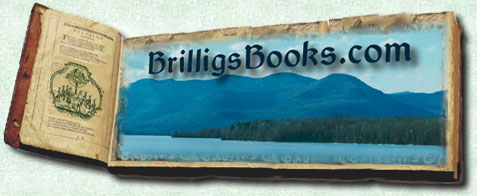
NEW:
Books To Read Around The Winter Fire - Great Holiday Gifts
Book Review: Alias Grace by Margaret Atwood
Books To Read Around The Winter Fire
One of my greatest joys has been to read to children, and to see them enraptured by books. Snuggled in blankets, in front of a winter fire, with hot apple cider and a cinnamon stick, I could often be tempted to read just one more chapter. Below you will find a few recommendations for books set in colonial times, a couple of all time favorites, and some non-fiction books that bring that period to life.
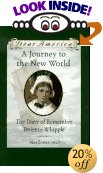 A
Journey to the New World, The Diary of Remember Patience Whipple Mayflower
1620 (Dear America)
A
Journey to the New World, The Diary of Remember Patience Whipple Mayflower
1620 (Dear America)
, by Kathryn Lasky. Twelve-year-old Mem is on board the Mayflower in 1620 with her parents and baby sister. Through details of everyday living, we get to know what it must have been like to be rocked at sea, and then to struggle through hunger and plague to live in a harsh land.
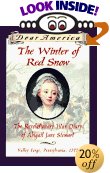 The
Winter of Red Snow: The Revolutionary War Diary of Abigail Jane Stewart,
Valley Forge, Pensylvania, 1777 (Dear America), by Kristiana Gregory.
General George Washington is moving his barefoot, thin, troops into Abigail's
town for the winter. Her mother takes in the General's laundry, and her
father, a cobbler, decides he can spare some sacks of grain, and make
them some shoes. But, it tries their patience when their front fence is
taken away for firewood, and deserters are publicly hung. If you have
the stomach for reality, this book will give a true picture of the period,
complete with historical information at the end.
The
Winter of Red Snow: The Revolutionary War Diary of Abigail Jane Stewart,
Valley Forge, Pensylvania, 1777 (Dear America), by Kristiana Gregory.
General George Washington is moving his barefoot, thin, troops into Abigail's
town for the winter. Her mother takes in the General's laundry, and her
father, a cobbler, decides he can spare some sacks of grain, and make
them some shoes. But, it tries their patience when their front fence is
taken away for firewood, and deserters are publicly hung. If you have
the stomach for reality, this book will give a true picture of the period,
complete with historical information at the end.
 Five
Smooth Stones: Hope's Diary, Philadelphia, Pennsylvania, 1776, (My America),
by Kristiana Gregory. Nine-year-old Hope’s family support the Patriots
during the American Revolution. First her father is missing, and then
her brother disappears. Could he have joined the Tories? All Hope wants
is to get her family back together.
Five
Smooth Stones: Hope's Diary, Philadelphia, Pennsylvania, 1776, (My America),
by Kristiana Gregory. Nine-year-old Hope’s family support the Patriots
during the American Revolution. First her father is missing, and then
her brother disappears. Could he have joined the Tories? All Hope wants
is to get her family back together.
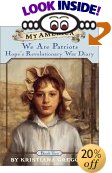 We
Are Patriots, Hope’s Revolutionary War Diary,Book Two (Dear America),
by Kristiana Gregory. Hope's family moves to Valley Forge and is reunited,
but she learns her father has joined the Sons of Liberty. Their whole
family may be at risk.
We
Are Patriots, Hope’s Revolutionary War Diary,Book Two (Dear America),
by Kristiana Gregory. Hope's family moves to Valley Forge and is reunited,
but she learns her father has joined the Sons of Liberty. Their whole
family may be at risk.
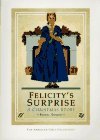 Felicity's
Surprise, A Christmas Story, by Valerie Tripp, illustrated by Dan
Andreasen. When the honor of her presence is requested to come to a dance
lesson at the Palace of Governor Dunmore of Virginia, who represents the
king of England, Felicity is delighted. Felicity’s going to the Governor’s
Palace could be considered an insult to the Patriots, says her father’s
apprentice, and states that Loyalists, who have refused to buy her father’s
tea, do not deserve her company. With her independent spirit, and her
mother’s permission, she decides to go. When a plain brown dress
is not acceptable, her mother promises to make her a beautiful blue dress.
But, her mother becomes very ill, and the possibility of her ever going
to the event seems impossible. This book is part of The American Girls
Collection, and third in a series that includes, Meet
Felicity, An American Girl, and Felicity
Learns A Lesson, A School Story.
Felicity's
Surprise, A Christmas Story, by Valerie Tripp, illustrated by Dan
Andreasen. When the honor of her presence is requested to come to a dance
lesson at the Palace of Governor Dunmore of Virginia, who represents the
king of England, Felicity is delighted. Felicity’s going to the Governor’s
Palace could be considered an insult to the Patriots, says her father’s
apprentice, and states that Loyalists, who have refused to buy her father’s
tea, do not deserve her company. With her independent spirit, and her
mother’s permission, she decides to go. When a plain brown dress
is not acceptable, her mother promises to make her a beautiful blue dress.
But, her mother becomes very ill, and the possibility of her ever going
to the event seems impossible. This book is part of The American Girls
Collection, and third in a series that includes, Meet
Felicity, An American Girl, and Felicity
Learns A Lesson, A School Story.
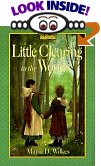 To
those who have been delighted with the Little
House books, by Laura Ingalls Wilder, it will come as a treat to find
three books about her mother, Caroline Quiner, as a child, written by
Maria D. Wilkes with illustrations by Dan Andreasen that enhance the text.
I picked up Little
Clearing in the Woods, the third book in the series, and gobbled it
up. But most readers would probably prefer to read On
Top of Concord Hill, and Little
Town at the Crossroads first.
To
those who have been delighted with the Little
House books, by Laura Ingalls Wilder, it will come as a treat to find
three books about her mother, Caroline Quiner, as a child, written by
Maria D. Wilkes with illustrations by Dan Andreasen that enhance the text.
I picked up Little
Clearing in the Woods, the third book in the series, and gobbled it
up. But most readers would probably prefer to read On
Top of Concord Hill, and Little
Town at the Crossroads first.
In Little Clearing, the Quiner family had to move when their homestead was sold out from under them. They found a tiny unfinished cabin in a forest in Concord, Wisconsin, thirty miles away. The harsh realities of changing a wooded area to farmland are met with fortitude, but also flexibility when the girls in the family are allowed to drag brush and saplings to the fire, ordinarily not considered a proper job for a girl. When their first crops are destroyed by a storm, they salvage what they can, and Caroline helps to find a way for the family to live through the winter.
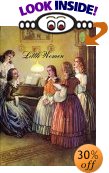 Little
Women, by Louisa May Alcott, with illustrations by Ann M. Magagna
and Louis Jambour. This 19th century classic is loved by many and still
relevant, and draws the reader in. It opens with the March family's preparations
for Christmas. Their lives are made difficult by their lack of money,
in part because their father is off with the Union army at war, and had
made a bad investment. They realize how caring for another family in need
can bring rewards from unexpected places. Jo desires to become a writer,
to stay independent, and learns that putting herself forward and staying
with her intentions, she can bring forth her dreams.
Little
Women, by Louisa May Alcott, with illustrations by Ann M. Magagna
and Louis Jambour. This 19th century classic is loved by many and still
relevant, and draws the reader in. It opens with the March family's preparations
for Christmas. Their lives are made difficult by their lack of money,
in part because their father is off with the Union army at war, and had
made a bad investment. They realize how caring for another family in need
can bring rewards from unexpected places. Jo desires to become a writer,
to stay independent, and learns that putting herself forward and staying
with her intentions, she can bring forth her dreams.
 Louisa
May Alcott's, Little Women, inspired Susan Beth Pfeffer to write Christmas
Dreams. Aunt March, who is thought to be of a mean temperament, has
decided to give away an antique cameo brooch to one of four sisters, Meg,
Amy, Jo, or Beth. Meanwhile, the girls have found a gift for their father
that they know is perfect for him, but beyond their reach. Each one wishes
to get the brooch for different reasons. Exploring money values and the
real meaning of Christmas, the ending will leave the reader feeling that
the right person got the piece of jewelry.
Louisa
May Alcott's, Little Women, inspired Susan Beth Pfeffer to write Christmas
Dreams. Aunt March, who is thought to be of a mean temperament, has
decided to give away an antique cameo brooch to one of four sisters, Meg,
Amy, Jo, or Beth. Meanwhile, the girls have found a gift for their father
that they know is perfect for him, but beyond their reach. Each one wishes
to get the brooch for different reasons. Exploring money values and the
real meaning of Christmas, the ending will leave the reader feeling that
the right person got the piece of jewelry.
 A
Christmas Memory, by Truman Capote, with illustrations by Beth Peck
tells of a boyhood friendship between the author at seven, and an old
woman, a distant cousin, with whom he lives. They push an old baby carriage
through the woods to get pecans to put in the fruitcake they make for
friends who strike their fancy, like President Roosevelt, and "…the
driver of the six o'clock bus from Mobile, who exchanges waves with us
every day as he passes in a dust-cloud whoosh." The illustrations
bring Capote's unique style to life, and you can almost feel the faded
velvet flowers on the lady's battered hat. Their celebration of Christmas
finds each friend making the best possible present they can for one another.
I love this book.
A
Christmas Memory, by Truman Capote, with illustrations by Beth Peck
tells of a boyhood friendship between the author at seven, and an old
woman, a distant cousin, with whom he lives. They push an old baby carriage
through the woods to get pecans to put in the fruitcake they make for
friends who strike their fancy, like President Roosevelt, and "…the
driver of the six o'clock bus from Mobile, who exchanges waves with us
every day as he passes in a dust-cloud whoosh." The illustrations
bring Capote's unique style to life, and you can almost feel the faded
velvet flowers on the lady's battered hat. Their celebration of Christmas
finds each friend making the best possible present they can for one another.
I love this book.
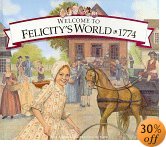 Welcome
to Felicity's World, 1774, by Catherine Gourley, Jamie Young, illustrator,
Jodi Evert, editor, and Mengwan Lin, designer. This vivid book is packed
with details of tools, accessories, and gives a broad view of life during
those colonial times, with pictures varying from embroidery, the making
of ink, to what a privy was like. It shows how it was to be the lady of
a wealthy home, or a young slave girl split from her family and sold.
At the same time it informs the reader with an historical view of what
battles and struggles are going on during the war against the British
Empire.
Welcome
to Felicity's World, 1774, by Catherine Gourley, Jamie Young, illustrator,
Jodi Evert, editor, and Mengwan Lin, designer. This vivid book is packed
with details of tools, accessories, and gives a broad view of life during
those colonial times, with pictures varying from embroidery, the making
of ink, to what a privy was like. It shows how it was to be the lady of
a wealthy home, or a young slave girl split from her family and sold.
At the same time it informs the reader with an historical view of what
battles and struggles are going on during the war against the British
Empire.
 Christmas
Decorations from Williamsburg, by Susan Hight Rountree, with drawings
by Elizabeth Hundley Babb, photography by David M. Doody and Tom Green.
Photos show some of the historic homes, including a shot of fireworks
streaking into the sky, and lighting up the Governor's Palace. Decorated
trees and costumed carolers stand in front of candle lit windows, while
many varieties of wreaths, garlands and mantel decorations are shown,
with clear directions for making them. In one dramatic two-page picture
we see a plaque with magnolia leaves forming the border, then rings of
apples, nuts, and cranberries on a boxwood bed. The pineapple in the center
is a traditional symbol of hospitality dating from colonial days. Pictures
of holiday tables filled with deserts are combined with recipes, for the
reader to serve on their own tables.
Christmas
Decorations from Williamsburg, by Susan Hight Rountree, with drawings
by Elizabeth Hundley Babb, photography by David M. Doody and Tom Green.
Photos show some of the historic homes, including a shot of fireworks
streaking into the sky, and lighting up the Governor's Palace. Decorated
trees and costumed carolers stand in front of candle lit windows, while
many varieties of wreaths, garlands and mantel decorations are shown,
with clear directions for making them. In one dramatic two-page picture
we see a plaque with magnolia leaves forming the border, then rings of
apples, nuts, and cranberries on a boxwood bed. The pineapple in the center
is a traditional symbol of hospitality dating from colonial days. Pictures
of holiday tables filled with deserts are combined with recipes, for the
reader to serve on their own tables.
 I
also recommend Great
Houses of the Hudson River, edited by Michael Middleton Dwyer, with
aerial photography by Steve Turner, and numerous other photographers credited
in the book. This elegant, large format book is for those who would like
to see magnificent photos with panoramic views of great estates along
the Hudson River in New York. There are shots of elegant rooms, interior
staircases, chandeliers, gardens and more, taken with exquisite use of
light.
I
also recommend Great
Houses of the Hudson River, edited by Michael Middleton Dwyer, with
aerial photography by Steve Turner, and numerous other photographers credited
in the book. This elegant, large format book is for those who would like
to see magnificent photos with panoramic views of great estates along
the Hudson River in New York. There are shots of elegant rooms, interior
staircases, chandeliers, gardens and more, taken with exquisite use of
light.
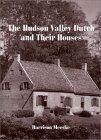 Another
book that gives sketches, pictures and clear text, is The
Hudson Valley Dutch and Their Houses, by Harrison Meeske. This is
packed with massive amounts of information, and covers details on architecture,
structure, construction, and much more. There are many drawings, pictures,
with vivid text. A comprehensive index, notes, appendix, and a glossary
compliment this book.
Another
book that gives sketches, pictures and clear text, is The
Hudson Valley Dutch and Their Houses, by Harrison Meeske. This is
packed with massive amounts of information, and covers details on architecture,
structure, construction, and much more. There are many drawings, pictures,
with vivid text. A comprehensive index, notes, appendix, and a glossary
compliment this book.
 The
Colonial Williamsburg Tavern Cookbook, give mouth watering recipes
developed by John R. Gonzales, edited by Charles Pierce, with photographs
by Tom Eckerle, published in association with The Colonial Williamsburg
Foundation. In the spring of 1772, George Washington dined with friends
at Christiana Campbell's Tavern. The receipt he signed is one of Colonial
Williamsburg's most treasured documents. The pictures of the building's
exteriors give a sense of this restored village's taverns. The interiors
enhance the foods where they are served. Shields Tavern Salmagundi is
served garnished with nasturtium, a recipe taken from a 1747 cookbook
The
Colonial Williamsburg Tavern Cookbook, give mouth watering recipes
developed by John R. Gonzales, edited by Charles Pierce, with photographs
by Tom Eckerle, published in association with The Colonial Williamsburg
Foundation. In the spring of 1772, George Washington dined with friends
at Christiana Campbell's Tavern. The receipt he signed is one of Colonial
Williamsburg's most treasured documents. The pictures of the building's
exteriors give a sense of this restored village's taverns. The interiors
enhance the foods where they are served. Shields Tavern Salmagundi is
served garnished with nasturtium, a recipe taken from a 1747 cookbook
 Pioneer
Women, Voices from the Kansas Frontier, edited by Joanna L. Stratton.
These are extraordinary accounts of life on the prairie commissioned by
the editor's great-grandmother who had intended them for a book. With
many illustrations introduced by historian, Arthur M Schlesinger, Jr.,
an index, and a bibliography, this book is an invaluable resource for
anyone who wants to study this subject.
Pioneer
Women, Voices from the Kansas Frontier, edited by Joanna L. Stratton.
These are extraordinary accounts of life on the prairie commissioned by
the editor's great-grandmother who had intended them for a book. With
many illustrations introduced by historian, Arthur M Schlesinger, Jr.,
an index, and a bibliography, this book is an invaluable resource for
anyone who wants to study this subject.
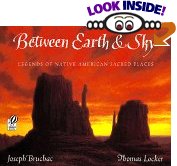 Between
Earth & Sky, Legends of Native American Sacred Places, by Joseph
Bruchac, illustrated by Thomas Locker. The exquisite paintings are combined
with words, verse and legends that honor and celebrate the land and traditions.
Between
Earth & Sky, Legends of Native American Sacred Places, by Joseph
Bruchac, illustrated by Thomas Locker. The exquisite paintings are combined
with words, verse and legends that honor and celebrate the land and traditions.